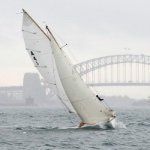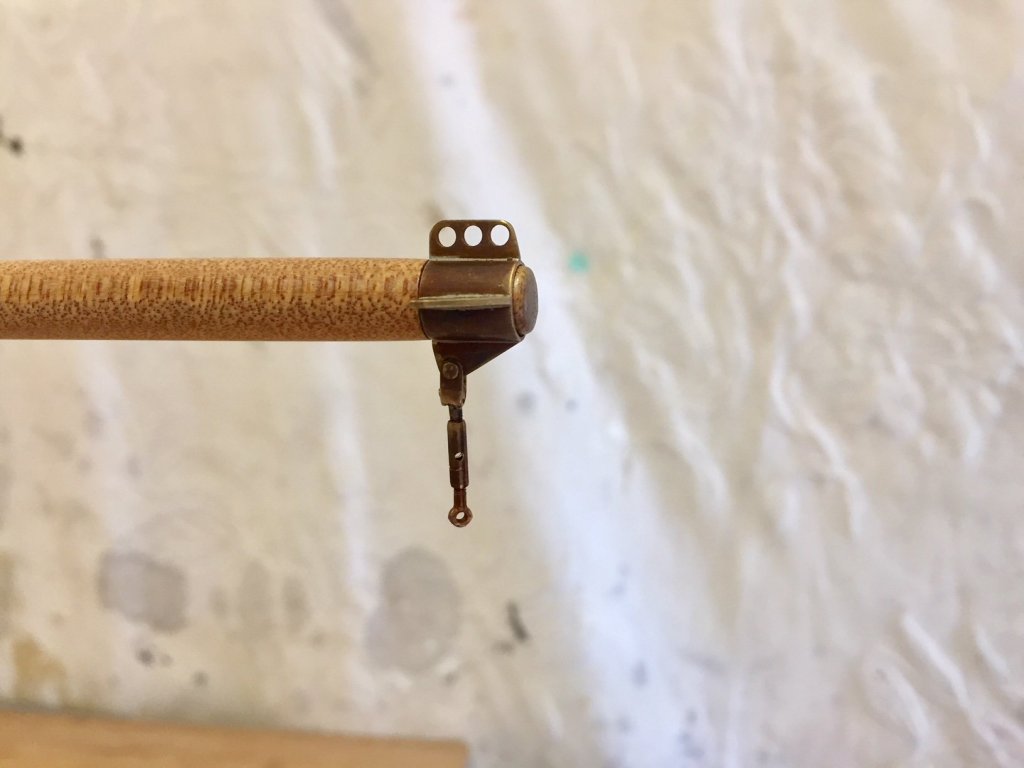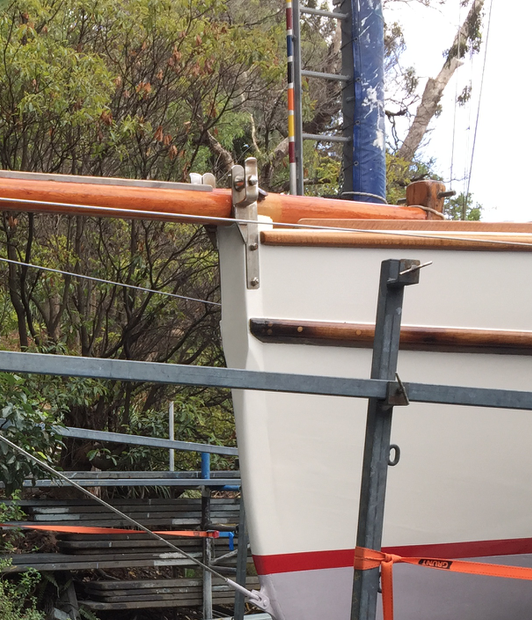-
Posts
830 -
Joined
-
Last visited
Content Type
Profiles
Forums
Gallery
Events
Everything posted by Mark Pearse
-
Hi Jack fascinating. The link you put in early in the posts was amazing, it's one thing to know they are fast & another to see it (even on screen). I'm guessing they were just too fast for a spinnaker? There's a wire, or maybe a shroud, that looks like it goes full length below the main fore/aft frame - what does that do? Mark
-
Masts usually go through a deck or cabin roof, a king plank does a lot of work but it wouldn't take any of the downwards mast loads. The mast goes down to the keel & usually sits on a mast step there (basically a beam that spreads the mast loads), the last would likely just go through the cabin roof & deck & maybe/maybe not be wedged against them; the mast can be free to move around a bit within a gap of about 1". I'm not sure what the detail is in the UK to waterproof this joint, but traditionally it would probably have been some sort of canvas boot, tied off to the mast & also tied off over a raised edge around the cabin top/deck hole. Even for a model, I would make sure you support the mast load down to the keel whether or not the mast goes through the cabin, timber can slowly bend over time from ongoing loads, & maybe even put in a mast step the equivalent of about 1-1.5m long. I wouldn't think 3 shrouds would be necessary, it's not a large yacht, & if you do gaff rig they are lower stress than bermudian...but you would need running backstays as well as the two each side on the mast - a cap shroud & a lower each side. On the rig, I believe that a gaff cutter would be a good choice (an internet search showed that they were done in this rig), because the boat is probably heavy & it's a more powerful rig than the triangular Bermudian mainsail. A cutter rig because that rig is very popular in the UK & this is definitely a classic English design. Lastly, the gaff rig just looks so damn good....but this is just the opinion of an idle bystander. On the transom, it was also popular to put the boat name on a wooden plate (or two). If your model has a double name then it might work to use plates & cover the drill damage that way...just a thought. I hope this assists, & the ultimate decision should be yours
-
the deck looks very good Vaddoc, were you thinking of doing the transom clear finished? I did an internet search to see what the rig is, & there seems to be a number of alternatives....what are you thinking? Mark
-
The main parts of the standing rigging are done; and the gammon iron is done & installed. The gammon iron is probably not accurate to reality, it has no bow rollers for anchoring etc. This is the point at which I want to separate the point of this model from doing a fully accurate model of a yacht. I won't be doing fairleads, bow rollers etc, the important part of this model is to realistically show the last yacht design by Cliff Gale, and some of the minor details will not be necessary. Partly this is because the details on a model seem to be more visible than on a real yacht, so in a way not doing them is trying to keep the focus on what I think are the most important parts - hull shape in particular. So, the mast bowsprit & standing rigging: Some of the rigging details, shrouds chain plate connections: Gammon iron: Mast cap from bow starboard side Mast cap seen from the stern side. The small rings will take the running backstays & the empty cleat is for the peak halyard. The spreaders:
-
Hi Russ I have found the Tamiya masking tape for model making use to be superb.
- 420 replies
-
- captain roy
- lugger
-
(and 2 more)
Tagged with:
-
I've been paying around with alternative swages for the rigging wire. They aren't really needed for the model, but actual rigging would have them, & they - at a model level - join the wire (jewellery SS braid, nylon coated, thank you brains trust) to the chain plates or turnbuckles. There would be other ways of doing it but I wanted something neat & not fussy. I experimented with heat-shrink tubing, but it looked too old fashioned for this yacht; & settled on using some aluminium tube & brass rod. The tube replicates a swaged joint & the rod tries v hard to look like a neat eye joint. You can see below the parts (ends of swages are chamfered) & the heat-shrink results, which don't look mechanical enough. Glue is CA. Brass rod into a eyelet, the other end of the rod gets glued into the aluminium tube. The cranse iron : Bobstay chainplate: Whisker stay chainplate: The overall. I'm especially pleased with this photo, the rigging joints should not jump out at you, so I think it's more or less in scale visually. thank you
-
Yes, that's the process I used. Tamiya masking tape from a hobby shop (recommended, great quality), being careful to burnish the edges of the making tape down, especially for the final waterline (boot top line). I didn't thin the waterline paint, so that it was thicker & would hopefully bleed under the tape less. There were some bleeds & I scraped them off with the tip of a knife blade when it was all dry. On the topsides paint, I did multiple thin coats of paint - maybe 4 coats - not worrying about whether is was opaque or not. Sanded between using 000 steel wool, or v fine paper.
-
Hi Vaddoc I used both acrylic & enamel for my hull, but I've only done it the once to a model so that's not much experience. I got some brushing thinners for both & didn't have any wet edge issues. I used gloss enamel for topsides & matt acrylic for the antifouling paint. Happy with both, but was very impressed with the acrylic - but I'm not sure though how good their gloss level is. The only surprise I found was that the Humbrol enamel really needed to be mixed for 5 minutes or it took days to dry. My experience with painting the model & also full size hulls is that you are best to brush lengthwise along the hull, & try to brush towards the wet paint rather than both directions, although it might not be possible to do that 100%. good luck with it...
-
Hi Vaddoc that looks great - I would think the deck will be enough to brace it, but bulkheads would be even better. Hi Druxey, I hadn't realised shellac was nasty stuff. Could you explain this, thanks. Mark
-
sensational Keith, well done & thank you for showing us, it's been inspiring to see all the best, Mark
-
thanks, it's been great learning how to do metalwork & soldering & the interest is heartening. Art, thanks for that, but I feel that your work on your own current model is beautiful indeed. thanks also Harley, & I looked up what a Ranger 29 is, a new yacht type to me. They are very nicely proportioned & I hope that you did get to sail in one. This yacht will have a large mainsail by comparison, which is good & bad....a 28' gaffer is powerful but maybe getting close to a handful. Sailor, thank you, that's good information. I asked a friend who remembers well many yachts racing before WWII & confirmed that they all had some sort of gammon iron; but interestingly his father's yacht was built without whisker stays because it was easier to drop & retrieve the anchor. Ultimately they did put whisker stays on, as they did more racing & preferred the bowsprit in one piece. Mark
-
turnbuckle for the whisker stay done & coloured: I was in a quandary about the bobstay chainplate.... the type I want to use has the base part faired to the stem shape; or the alternative is that sometimes the fitting has two plates in a Y, surface mounted on the hull but I am not so keen on that type, I think it would be better to bolt through the stem timbers for this most significant fitting, than laterally through it & planking (maybe solid blocking was used). If the protruding flange was all I made (& pretend the rest was there but just painted over), then fixing it would be tricky as there would be some load on the model fitting. But the base part & flange all in one seemed tough. In the end I shaped it all, cut & shaped down from some brass flat bar about 2mm thick. Then fixed in place. The rivets are glued into holes, & when the glue is dried I will sand the heads down a bit, they stick out a bit too much. Then fill around the sides a bit & paint it, & do the bobstay itself. I haven't gone through it completely in my head yet but I think that then I can do the stays & shrouds. The actual fitting would have a central cast bolt also, behind the flange, but the two end ones must be loose because the three bolts would not be parallel. The fitting is about 20mm long, so 240mm actual, & about 25mm thick actual dimension.
-
yes, that's it - the fitting at the top of the stem - like this, in this case it also has some bow rollers - but I'm not sure it's needed to hold the bowsprit down in all cases, assuming the bowsprit is housed into the samson post thanks for clarifying - & what do you mean by "gammoning is the rope"?
-
thanks all. Keith, I stabbed myself with a piece of brass & was bleeding, (& I won't say what I was using as a hammer but it's right up there with using a chisel as a screwdriver). Sailor - thanks, yes that does sound familiar now. Do you recall what the name of the fitting at the top of the stem would be? Gammon....?
-
It still looks like canvas to me, painted canvas. Interestingly the patterns look like ecclesiastical architecture of the same period ie: gothic; & in some examples shown they have a cross at the peak. Also these last 2 pictures appear again to show the canvas open to the forward side. I wonder if they were an on-board chapel (or maybe just the nave part), & when the canvas was opened to expose the nave & altar - facing forwards - the deck became like the chapel interior. If the outside were painted using architectural imagery, that would also follow. The peak represented the tower....? Would these vessels have had a priest on board?
-
I managed a couple of hours today of happy modelling & made the whisker stay turnbuckle connections. And this time I thought I'd photograph how I made them, I doubt the technique is original but it is interesting to see how others do things & I've been a bit reluctant considering the refined techniques that others here are masters of - but it's time to be "out & proud" as they say....no more being sheepish about using mediaeval technology. The whisker stay chainplates were already made, & I had purchased some very nice - & well scaled - turnbuckles. The turnbuckles had previously had one end converted from an eyelet to a T end, to allow this junction. The point of the junction is to have the turnbuckle directly connected to the chainplate, similar to an actual rigging detail. The basic equipment - rod, think flat bar & a thicker flat bar for use as a spacer: Bend the thin flat bar, the rod is what I used for the T end of the turnbuckle so it's the correct diameter for the inside of the U: Drill the U bend in the flat bar, the turnbuckle shaft will go through here: Clean up the inside of the U (the sanding block is on 1.5mm styrene, with a rounded edge): Clamp the spacer & squeeze the U closed a bit more, the thickness of the spacer matches the width of the chain plate eyelet: Drill through both: Make a rivet, thicken the end with some gentle taps: Roughly assembled: Cleaned up & fully assembled: 15 seconds in the darkening solution, then installed on the hull by glueing the chainplate rivets into holes in the hull:
-
Hi Keith beautiful. Also, your techniques were very well thought out. On the prop, I agree with all you said except that you usually wouldn't need to remove the rudder to slip the shaft out: a scallop in the leading edge of the blade would give the space to slide it out with attached rudders like this. Mark
-
Hi Hakan for this model, are you doing the hull shape by eye - same as you described the actual builders did?
-
Yes from the picture I'd also guess some sort of fabric construction. I know nothing of these craft, but the artwork itself is interesting: they attempted accuracy, but it was before "scientific" art, "true" perspective etc so it does look a bit funny to us. They showed things in a stylised & perfected way, if it was fabric it was without breeze, dirt, disorder. I can't see the details well on the reproduction, but it possibly looks as if it can be open or closed on the bow side. A bit of shelter is always good on a boat & even better if it's adaptable, could it be as pragmatic as that?
About us
Modelshipworld - Advancing Ship Modeling through Research
SSL Secured
Your security is important for us so this Website is SSL-Secured
NRG Mailing Address
Nautical Research Guild
237 South Lincoln Street
Westmont IL, 60559-1917
Model Ship World ® and the MSW logo are Registered Trademarks, and belong to the Nautical Research Guild (United States Patent and Trademark Office: No. 6,929,264 & No. 6,929,274, registered Dec. 20, 2022)
Helpful Links
About the NRG
If you enjoy building ship models that are historically accurate as well as beautiful, then The Nautical Research Guild (NRG) is just right for you.
The Guild is a non-profit educational organization whose mission is to “Advance Ship Modeling Through Research”. We provide support to our members in their efforts to raise the quality of their model ships.
The Nautical Research Guild has published our world-renowned quarterly magazine, The Nautical Research Journal, since 1955. The pages of the Journal are full of articles by accomplished ship modelers who show you how they create those exquisite details on their models, and by maritime historians who show you the correct details to build. The Journal is available in both print and digital editions. Go to the NRG web site (www.thenrg.org) to download a complimentary digital copy of the Journal. The NRG also publishes plan sets, books and compilations of back issues of the Journal and the former Ships in Scale and Model Ship Builder magazines.





